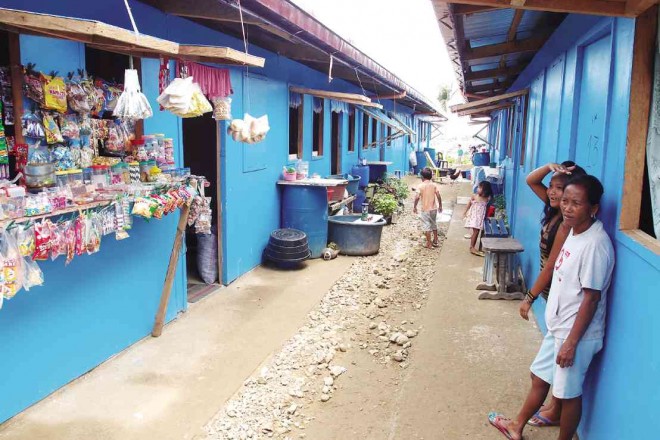Lack of implementation riles mayors in Visayas

EVACUEES in a community of bunkhouses in Barangay Gogo in Estancia, Iloilo, have put up variety stores to help meet their basic needs. NESTOR P. BURGOS JR./INQUIRER VISAYAS
(Second of three parts)
Local officials in areas ravaged by Supertyhoon “Yolanda” are frustrated over the long delay in the release of housing assistance to the victims.
Mayor Rene Cordero of Estancia, one of the most ravaged towns in Iloilo province, said he had submitted many documents to validate beneficiaries’ claims “months ago.” He is still clueless on when the help will arrive.
In Cebu province, Mayor Ricardo Ramirez of Medellin town said no housing aid from the national government came although the provincial government had submitted a recovery plan.
Only foreign and local nongovernment organizations (NGOs) have helped, Ramirez said. “The NGOs were the ones that helped. Even the municipal government cannot extend any help,” he said.
While food aid from the national government has been more than enough, “not a single centavo” came for rehabilitation, Ramirez said.
The mayor said he and his colleagues had been called to attend “meetings after meetings” but no definite timetable had been given for the help.
“I’m sick and tired of all those meetings. I want to hear
the word ‘implementation,’” Ramirez told the Inquirer.
Biggest gap
In Daanbantayan, also in Cebu, Mayor Augusto Corro said he considered shelter the “biggest gap” in the town’s rehabilitation.
About 3,000 families are still in danger zones, Corro said. While NGOs have committed to build 400 houses, the local government unit doesn’t have land for these.
Mayor Erwin Yu of Tudela town, also in Cebu, said 12 houses had been built on a relocation site in Sitio Fatima, Barangay General, for people living near the shore in Barangays Southern Poblacion and General. A total of 168 families will be transferred.
Tudela was the first town that inaugurated a relocation site. Mayor Salvador de la Fuente of Madridejos, Cebu, said the municipal government would move about 1,000 families from 11 coastal barangays to a lot in Barangay Tugas, a Gawad Kalinga humanitarian project. He said he needed funding to build the houses.
Limited resources
While the reconstruction of houses has begun in Sta. Fe in Cebu, Mayor Jose Esgana said the town’s resources were limited. He said that while local government units had already submitted rehabilitation plans, “nothing is happening.”
“We will start again with proposals,” Esgana said, expressing dismay.
Bogo Mayor Celestino Martinez Jr. said the city government had to suspend the repair of government infrastructure to concentrate on rebuilding houses.
In Balangiga, Eastern Samar province, Mayor Viscuso de Lira said the town had received P2 million from the state-owned Philippine Charity Sweepstakes Organization but none from the national government.
“The national government is very, very slow in helping us in affected areas. They are not helping us enough,” said De Lira, who identified himself as an administration ally.
His disgust is shared by other mayors, including Mayor Alfred Romualdez of Tacloban City, considered the worst-hit area.
Tacloban’s finances have shrunk, partly because the city’s businessmen chose not to reopen their establishments. This has forced the scaling down of the city’s annual budget this year from P800 million to just more than P629 million.